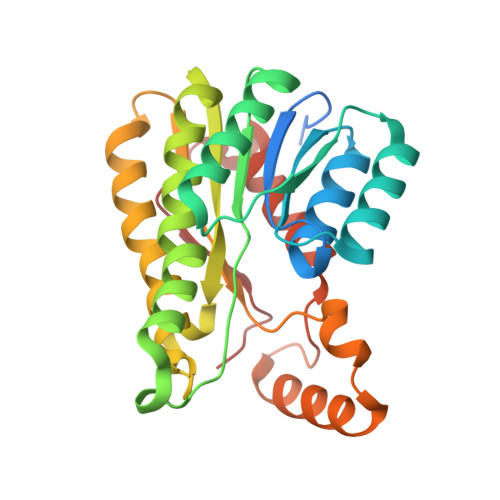Comprehensive Analysis of a Novel Ketoreductase for Pentangular Polyphenol Biosynthesis.
Valentic, T.R., Jackson, D.R., Brady, S.F., Tsai, S.C.(2016) ACS Chem Biol 11: 3421-3430
- PubMed: 27779377
- DOI: https://doi.org/10.1021/acschembio.6b00658
- Primary Citation of Related Structures:
5THQ, 5TII - PubMed Abstract:
Arixanthomycins are pentangular polyphenols (PP) with potent antiproliferative activities that were discovered through the heterologous expression of environmental DNA-derived gene clusters. The biosynthesis of arixanthomycin and other PPs is unusual because it requires several novel type II polyketide synthase (PKS) enzymes for its complete maturation. Most type II PKSs contain a ketoreductase (KR) that mediates the C7-C12 first ring cyclization and C-9 reduction. In contrast, based on previous studies of product analysis and genome mining, the arixanthomycin (ARX) gene cluster harbors a C-11 reducing KR (ARX 27), a C9-C14 first-ring aromatase/cyclase (ARX 19), and an unprecedented C-17 and C-19 reducing KR (ARX 21). While bioinformatics is useful for predicting novel enzymes, the functions of ARX 19, ARX 21, and ARX 27 have yet to be confirmed. Further, the structural features that predispose the ARX biosynthetic enzymes to process atypical poly-β-ketone scaffolds remain unknown. We report the crystal structure of ARX 21, the first structure of an enzyme involved in PP biosynthesis and likely a C-17 and C-19 reducing-KR, which is structurally similar to C-15 reducing KRs. Structural comparison of ARX 21 and other C-9 reducing KRs revealed a difference in the enzyme active site that may enlighten the molecular basis of KR substrate specificity. In addition, we report the successful in vitro reconstitution of ARX 19. The structural characterization of ARX 21 in conjunction with the in vitro results of ARX 19 lays the groundwork toward a complete in vitro and structural characterization of type II PKS enzymes involved in PP biogenesis.
Organizational Affiliation:
Department of Molecular Biology and Biochemistry, Chemistry, and Pharmaceutical Sciences, University of California, Irvine , Irvine, California 92697, United States.















